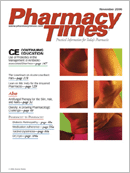Publication
Article
Pharmacy Times
Lean on Me: Help for the Impaired Pharmacist
Author(s):
Although the issue of substanceabuse among pharmacists isseldom discussed, it is anissue of fundamental significance thatcan negatively impact the pharmacyprofession. In addition, it can hinder thework performance of the affected pharmacists,thus compromising both theintegrity and the quality of patient care.Substance abuse touches individuals invarious health care fields. According tothe National Institute on Drug Abuse, itis estimated that 8% to 12% of healthcare workers have substance abuseproblems.1 Furthermore, 11% to 15% ofpharmacists, at some time in theircareer, are confronted with alcoholand/or drug dependency problems, andthe median age of recovering pharmacistsis 43 years.2
In 1982, the American PharmacistsAssociation acknowledged that substanceabuse was an issue within theprofession of pharmacy, which resultedin the establishment of the PharmacyRecovery Network (PRN).3,4 The PRN is aconfidential program which providesassistance in the early recognition,intervention, and treatment of substanceabuse among affected pharmacists,pharmacy students, and pharmacytechnicians.4 In addition, many stateshave formed intervention and recoverytreatment programs that are typicallyavailable 24 hours a day to assist pharmacistsafflicted with substance abuseproblems. The majority of treatmentprograms function with a multidisciplinarystaff that can include a psychiatrist,a social worker, and a psychologist,as well as those trained in medicationaddiction.3 Some of those working in thePRN programs are in recoverythemselves.3
Approximately two thirds ofimpaired pharmacists in recoverytreatment programs werediscovered by their local stateboard of pharmacy, a peer, oranother health care professional.4 Studies suggest that certainfactors may predispose pharmaciststo the development of asubstance abuse problem; forexample, stress associated withworking conditions or the demandsof working long shifts,personal issues, or the beliefthat their knowledge of medicineswill somehow preventthem from becoming addicted.3The abuse of alcohol and otherdrugs in the work setting hasbeen found to be the singlelargest contributing factor to theproblem of employee impairmentand lost productivity.5Results from a study published byMcAuliffe et al showed that 46% ofpharmacists and 62% of pharmacy studentsreported using a prescription drugwithout an authorized prescription.3,6 Inaddition, 20% of the pharmacists surveyedreported that they had used aprescription drug without an authorizedprescription at least 5 or more times intheir lifetime.4
Characteristics of SubstanceAbuse
Many pharmacists with substanceabuse problems initially think that theirtrained knowledge of drugs will somehoweliminate the potential for substanceabuse. They seem to functionnormally in their daily pharmacy practice,despite the substance abuse; however,these individuals may exhibitbehavioral characteristics that can alertothers to the problem. Examples ofsigns and symptoms of substanceabuse include:4
- Personality changes or mood swings
- Frequent absences from work
- Volunteering to check in narcotics or do inventory on them
- Long or frequent disappearances from the work station
- Increase in medication errors
- Changes in physical appearance (eg, weight loss or poor hygiene)
- Showing signs of forgetfulness, irritability, and tardiness
- Decrease in work performance
- Excessive ordering of certain drugs
- Overreaction to criticism
- Increased complaints from patients
The Road to Recovery
When pharmacists have been identified as having a substance abuseissue, they are not allowed to practicepharmacy until the problem isresolved.4 Each state board of pharmacyhas its own regulations and proceduresfor addressing the issue of apharmacist suspected of substanceabuse.3 Impaired pharmacists can bereassured that, with the assistance ofPRN programs, they can face theiraddictions and get necessary treatment.The success rate for many of thePRN programs is as high as 85%.1,6 It isimperative for impaired pharmaciststo adhere to treatment plans and complywith the terms of returning to thepractice of pharmacy in order toremain in good standing with theirlocal boards of pharmacy. Pharmacistswho participate in these programs aregenerally required to sign a contractthat obligates them to adhere to certainrules and regulations that requirethem to maintain routine contact withan assigned counselor, submit to randomdrug testing, and attend regularlyscheduled support group meetings.1Impaired pharmacists need long-termcare and follow-up to reduce the likelihoodof a relapse, as well as assistancefrom family, peers, and supportnetworks.
Conclusion
Pharmacists facing the challenge ofovercoming an addiction have manyresources at their disposal. Recovery isa realistic goal when the affected pharmacistmakes a commitment to therapy.Recognizing the signs and symptomsof a substance abuse problem andacknowledging that the problem existsare the most crucial steps on the roadto recovery. Through proper interventionand treatment, it is possible forimpaired pharmacists to once againachieve a better quality of life that isproductive and free of substance abuseand function once again as a responsiblehealth care professional. Earlyrecognition of a substance abuse problemcan prevent impaired pharmacistsfrom compromising patient care andavert serious consequences that mayinvolve medication errors.
Pharmacists are often consideredsome of the most trusted and respectedhealth care professionals. It is thefundamental responsibility of the pharmacistto assist others affected by substanceabuse; therefore, it is essentialfor all pharmacists to be knowledgeableabout substance abuse and to knowhow to identify its characteristics. Theyshould also be aware of the resourcesavailable for treatments for either themselvesor an affected coworker. Formore information on the various pharmacyrecovery programs available, contactyour local state board of pharmacyor your state pharmacy association.
Resources
For more information, please visitthe following Web sites:
- American PharmacistsAssociation AddictionPractitioner Interest Group atwww.aphanet.org
- American Society of AddictionMedicine at www.asam.org
- International PharmacistsAnonymous at mywebpages.comcast.net/ipa/ipapage.htm
- National Institute on DrugAbuse at www.nida.nih.gov
- USA Pharmacist RecoveryNetwork at usaprn.org
Ms. Terrie is a clinical pharmacywriter based in Haymarket,Va.
For a list of references, send a stamped,self-addressed envelope to: ReferencesDepartment, Attn. A. Rybovic, PharmacyTimes, Ascend Media Healthcare, 103 CollegeRoad East, Princeton, NJ 08540; or send an emailrequest to: [email protected].

Newsletter
Stay informed on drug updates, treatment guidelines, and pharmacy practice trends—subscribe to Pharmacy Times for weekly clinical insights.






